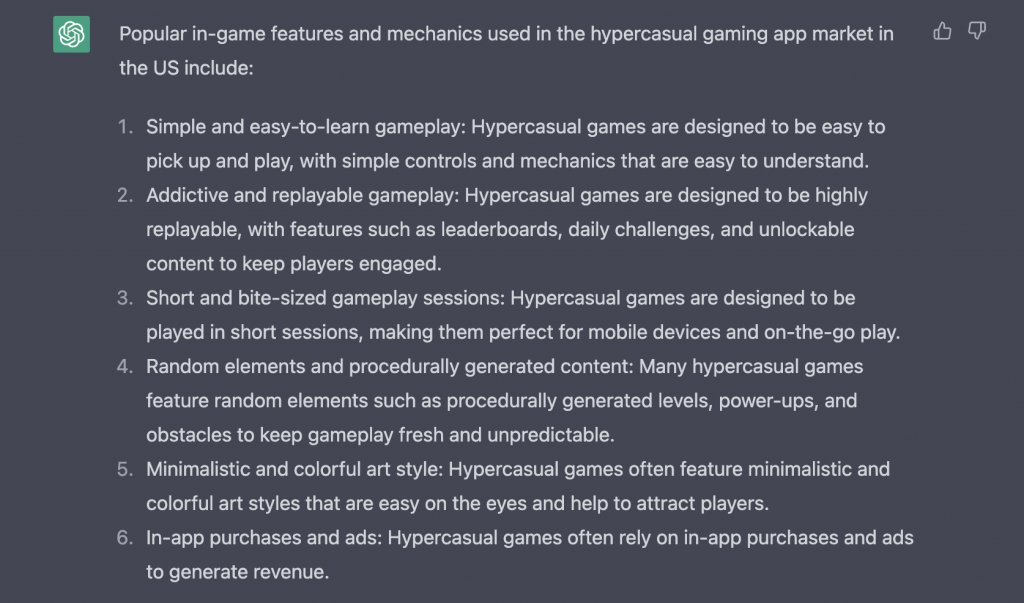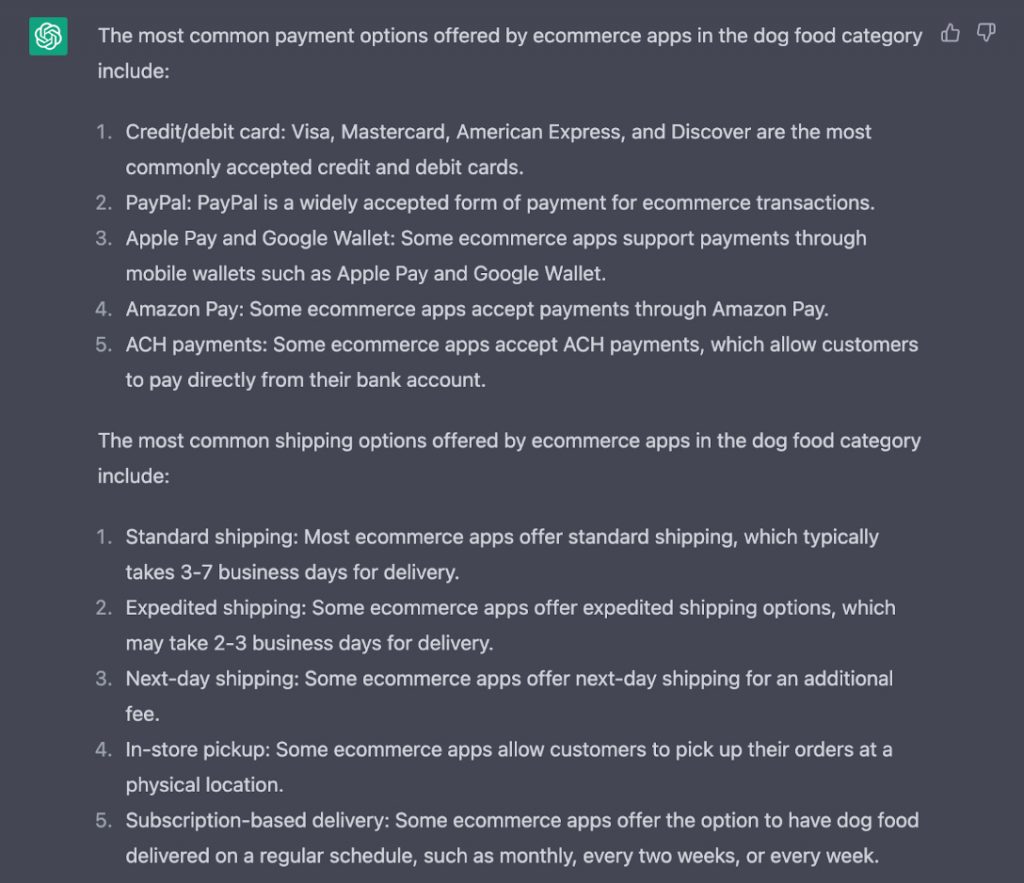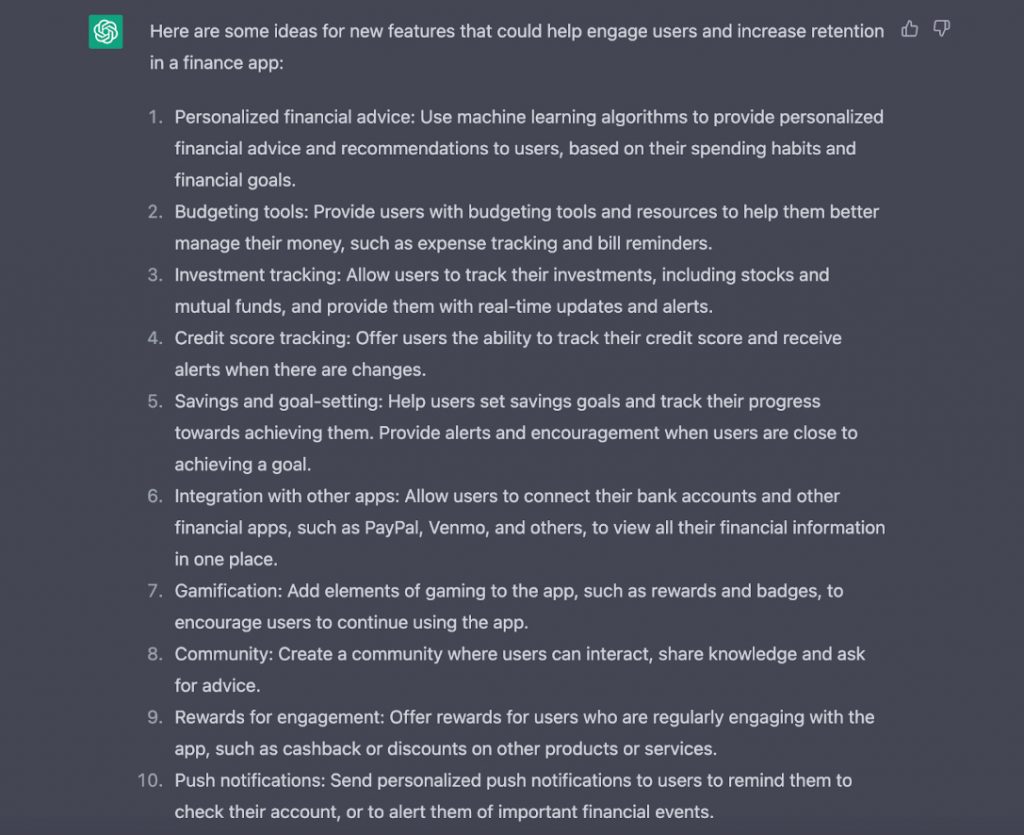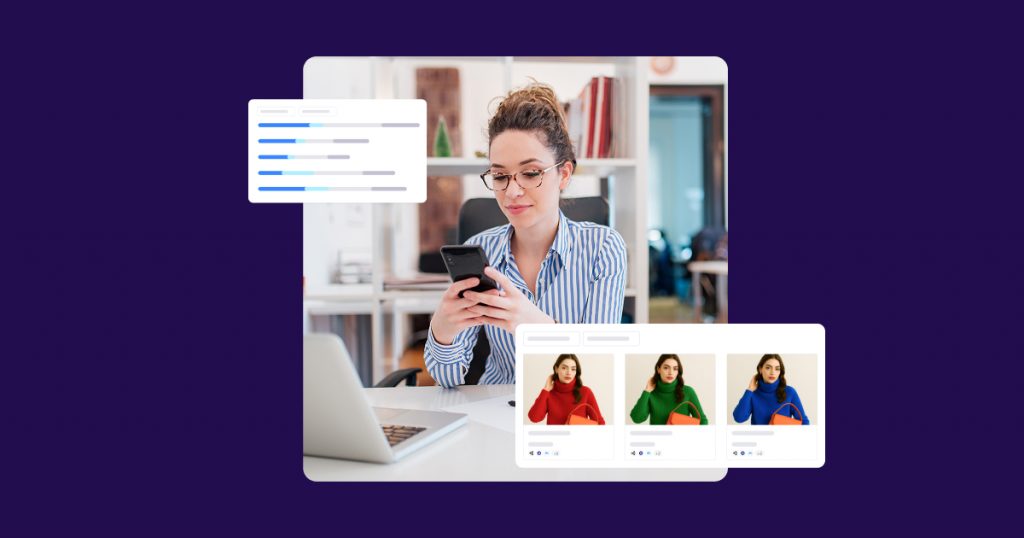
Part of our job as marketers is being curious. And staying relevant.
That means exploring new technologies, understanding how they can impact us, and putting them to use in our day-to-day lives.
ChatGPT (whether you like it or not) will change how we do marketing. Slowly at first, but the possibilities are endless and the pace of learning and innovation is already explosive.
This technology has the potential to save you and your team thousands of hours. But you need to know what to use it for and how. It’s not a substitute for strategic thinking or creativity for example, but it is killer at helping you speed up the ideation and creation processes as well as offering you different angles and insights.
Let’s dive in!

Conduct market research and competitor analysis
Before you start throwing money at marketing your app, it’s probably a good idea to conduct market research to gain a clear understanding of the market landscape. This insight will direct your marketing strategy, clarify your brand messaging, and identify key channels to focus on for user acquisition.
Here are a few practical ways to get started using ChatGPT as a friendly companion to speed up your research process.
Unearth basic market insights and generate forecasts
Starting at the highest level, ChatGPT can help generate insights and trends that provide a bird’s eye view of your niche.
Think about the types of questions you might want to ask when researching a new market:
- What is the current size and growth rate of the market?
- Who are the major players in the industry and what is their market share?
- What are the major trends and developments in the industry?
- What are the main drivers and constraints of the market?
- What is the competitive landscape like and how is it likely to change in the future?
- What are the key success factors for companies operating in this market?
- What are the major challenges facing the industry?
- What are the most promising segments or niches within the market?
- How is the market expected to evolve in the short term and long term?
- What are the opportunities for new entrants or existing companies to expand their market share?
Guess what? You can actually turn those questions into a prompt…
Answer the following questions from the point of view of a mobile app in the [your category e.g. gaming] industry:
- What is the current size and growth rate of the market?
- What are the key success factors for companies operating in this market?
- How is the market expected to evolve in the short term and long term?
When I did it for the gaming app market, I got back some things I expected —it’s a highly competitive market dominated by household names — along with a few things I didn’t, like concerns around the impact of gaming on mental health.
Didn’t get a result you expected, or don’t feel it’s comprehensive enough? Just remember, ChatGPT is always learning. So experiment with different prompts and be as specific as possible.
Here are some additional ideas for prompts that’ll give you more insight into the market landscape for your app:
I am developing a [app category] app. Generate a market research report for [industry] that highlights key trends, drivers, challenges, and opportunities. Provide sources wherever possible.
I am developing a [app category] app. Based on recent research, generate a market forecast that highlights the biggest threats and opportunities on the horizon. Expand on each point with data to back it up.
Generate a summary of the competitive landscape of [industry] and/or [market] and identify opportunities for differentiation.
Generate a summary of the competitive landscape of [industry] and/or [market] and identify opportunities for differentiation.
Now let’s take a more concrete example.
Say you’re developing a new hyper-casual gaming app in Europe and want to understand the market potential. You might find some of the following prompts useful:
What are the most popular platforms and devices for playing [type of game] games in the [category] market in [region and/or countries] and how does this impact the development and distribution of our game?
What are the key features and elements that make a successful [type of game] game in the [category] market in [region and/or countries]?
What are the most popular in-game features and mechanics used by other games in the [category] market in [region and/or countries] and how can we use them to improve our game?
What are the key demographics of players in the [category] market in [region and/or countries] for [type of game] games and how can we target and appeal to these demographics with our game?
Who are the key competitors in the [category] market in [region and/or countries] for [type of game] games and how does our game compare in terms of features, gameplay, and monetization?
I tried out this prompt: “What are the most popular in-game features and mechanics used by other games in the hyper-casual gaming app market in the US and how can we use them to improve our game?” and got the following response:

Analyze your competition
A key component of any market research includes mapping your competitive landscape — something that you can leverage ChatGPT to do for you, for a particular market or industry.
For competitor research, one idea that comes to mind is compiling information from aggregators like Crunchbase or review sites like TrustRadius, inputting this content into the chat, and asking for a summary back.
You can then transform that data into a table and even prompt ChatGPT to organize it for you by various dimensions, like funding, market cap, top words mentioned, and more.
For additional angles you might want to try some of the following prompts:
Generate a competitive analysis report for [industry] that compares and contrasts [competitor 1], [competitor 2], and [competitor 3].
Identify the most significant players in the [industry] market and analyze their business models, products and services, and market positioning in a matrix format.
What are the top features of [competitor app name] that sets it apart from other apps in the [niche] category?
What are the most common user demographics for apps in the [niche] category and how does [competitor app name] target and appeal to these demographics?
What are the most popular pricing models for apps in the [niche] category and how does [competitor app name] compare in terms of pricing and value for money?
What are the most common channels and strategies used by apps in the [niche] category to acquire and retain users, and how does [competitor app name] compare?
What are the main user complaints about [competitor app name] and how do they compare to other apps in the [niche] category?
Taking this down to the ground once again, let’s say you have an eCommerce app. You might want to consider additional questions that apply to your niche, such as:
What are the most common channels and strategies used by eCommerce apps in the [niche] category to acquire and retain customers, and how does [competitor app name] compare?
What are the most common channels and strategies used by eCommerce apps in the [niche] category to acquire and retain customers, and how does [competitor app name] compare?
What are the most common payment and shipping options offered by eCommerce apps in the [niche] category and how does [competitor app name] compare?
What are the most common customer service and return policies offered by eCommerce apps in the [niche] category and how does [competitor app name] compare?
I tried out a variation on one of the above prompts: What are the most common payment and shipping options offered by eCommerce apps in the dog food category?
Here’s what I got back:


Brainstorm ideas for new app features
Building out new and innovative app features is the best way to gain and retain app users. And one of the biggest steps when building out a roadmap is having a comprehensive backlog of potential feature ideas.
ChatGPT can help you come up with new app features based on:
- Existing research (for example, personas, pain points, and competitors)
- Features you already have (like reminders or referrals)
- Your goals (such as decreasing drop-off during onboarding, or increasing retention after Day 30)
The three key elements in generating useful answers are:
- Identifying your app category
- Describing your user persona
- Asking for output in a specific way — like a summary, list, or table
Here’s how to construct your prompt
First, set the stage by defining your app category and who your app is for:
I am building a [app category] app for a specific user persona. They are [describe persona in detail].
Then be clear about what kind of ideas you need:
- Generate a list of [x number] potential new app features that address the needs and pain points of my persona.
- Brainstorm a list of [x number] innovative features that will set my app apart from its competitors.
- Identify untapped opportunities and generate [x number] app feature suggestions that address them.
Lastly, format the answer in a digestible way:
- Present the answers in a table.
- Present the answers in a bulleted format.
Bringing that all together, we have the following prompt:
I am building a fitness app for a specific user persona. They are focused on being as healthy as possible, eating healthily, being productive, and staying on top of the latest health trends. They spend on average two hours at the gym, four times a week. They like influencers like Ronda Rousey, Cristiano Ronaldo, and Michael Phelps. Generate a list of innovative app features that will set my app apart from its competitors. Present the answers in a table.
Pro tip: based on the answers you get, you may want to select one of the app feature recommendations and then prompt ChatGPT to come up with alternatives.
You can also come at this from the angle of the problem you’re trying to solve.
For example, I ran: Users are dropping off in my finance app after day 30. List ideas for new features in finance apps that will help engage users and increase retention.
Here’s the response I got back:

Pretty good recs, right?

Content marketing ideation
AI-generated or AI-augmented content is one of the hottest topics and biggest use cases for AI in marketing right now.
Generating ad copy at scale, writing emails, and creating social posts are only the tip of the iceberg. App marketers can effectively use AI to not only help write content, but to help with ideation, briefs, analysis, editing, translation… the list goes on!
But here’s my BIG disclaimer: “help” is the operative term here. I strongly recommend against using AI as an end-to-end solution for your content needs, because it cannot replace human strategizing and creativity.
Now let’s explore some of the most prominent use cases for ChatGPT in content marketing.
Generate new ideas (or riff off of existing ones)
Marketing done right doesn’t start with “I want to run a campaign” or “I want to write a post for Facebook”. It starts with a problem that you or your customers are trying to solve.
You can devise a prompt to help brainstorm a list of content ideas to fill in any gaps.
First, set the stage in as much detail as possible:
I am marketing an [app category] app to [persona]. Ideate [X number] of content ideas for a [content type] on [your niche] for [specific subset of persona].
Then define your parameters:
- Use non-conventional examples
- Integrate humor in the ideation phase
- Utilize high-volume and low competition keywords
- Use the following list of ideas as inspiration: [paste your existing list of ideas]
Lastly, format the answer:
- Generate a list of subtopics for every topic generated
- Format it into a table
- Format the list as a CSV in a code box
- Format the results in a numbered list
Bringing that all together, we have the following prompt:
I am marketing a fitness app to new moms. Ideate 3 content ideas for a blog on yoga and the benefit for new moms. Use non-conventional examples. Generate a list of subtopics for every topic generated.
Here’s what I got:
There are so many ways (and formats) in which you could use the above ideas… from campaigns to blog posts, and from emails to in-app messages. The sky’s the limit.
Create campaign copy
Whether it’s writing an ad, an email, a text message, or even a blog post, ChatGPT can help.
Keep in mind that effective copy speaks to the human experience and tells a compelling story, which isn’t exactly ChatGPT’s specialty. But with the right prompts, it will help you do most of the heavy lifting.
Here’s how.
First, set the stage by describing where your content will live and what action you want your user to take:
Generate a list of [X] [channel + format] about [key message] to get users who are [persona details] to [desired action].
For the medium and format, you can try different combinations like:
- Facebook captions
- Email subject lines
- SMS text copy
For key message, you might want to think about things like:
- Problems your app solves
- Benefits of your app
- Features your users haven’t tried yet
- New feature releases or product updates
- A special promotion
- Highlights versus your competition
For desired action, consider your goals:
- Re-engage with my app
- Buy something in my app
- Install my app
Then, describe your voice and tone:
- Use my brand voice which is described as [describe voice]
- Use the voice and tone of [writer, influencer, artist]
Include guidelines and limitations:
- Use [x] number of characters
- Do not use [x phrase]
- Don’t use the passive voice
- Use strong, persuasive language
And add a twist to make it fun and unique:
- Make it a haiku
- Use emojis
- Write it as if you were William Shakespeare
- Add ellipses to every second sentence
Bringing that all together, we have the following prompt:
Generate a list of 10 Facebook captions about a 20% off promotion to get users who are 20-year-old females who like shopping to purchase clothing in my app. Use my brand tone and voice which is fun, quirky, and smart. Limit each caption to 10 words maximum and use emojis.
Full disclosure: I input the above prompt and wasn’t super impressed with the results. So what did I do? I re-prompted ChatGPT with “Take the first 5 and make them funnier” and here’s what I got back:
Once I’ve generated these, I might think about where else I’ll be pushing my campaign and prompting ChatGPT to modify this for different channels and ad formats.
You can use this framework for SO many different aspects of content creation. The potential is endless.
Edit and optimize your content
This is a use case that we’ve already embedded into our marketing workflow here at AppsFlyer, specifically when it comes to ideation on how to optimize top-performing content and refresh older pieces of content.
It’s also super applicable to app marketers. You can ask ChatGPT to review existing ad copy, emails, SMS campaigns, and really any written content you’re trying to promote, and provide suggestions on how to improve the wording from a variety of angles.
Here are a few prompts to help you get started:
- I have written the following post included in quotes “[paste your post].” List specific ways you would improve this post
- Edit this video script and make sure the tone is short and conversational: “[paste your article]”
- Shorten the length of this paragraph: “[insert paragraph]”
- Make this headline punchier: “[insert headline]”
- Rephrase this email to be in the active voice: “[insert email]”
- Rewrite the following Instagram ad copy to be in the 5th grade reading level: “[insert ad copy]”
- Rephrase the following Facebook ad copy to be more casual: “[insert ad copy]”
- Rewrite the following as if it were written by J.R.R. Tolkien: “[insert content]”
Come up with new A/B testing ideas
Ever found yourself racking your brain for different variations of copy to try out new A/B tests? Well, now you have ChatGPT to help speed up that process. Significantly.
Take your winners, pop them into ChatGPT and ask it to create new versions to test out.
Pro tip: it’s also a great way to easily format and test how different styles and sentiments resonate with your audience.
Let’s see it in action:
Imagine the winning ad copy of a campaign I ran for my travel app was “Direct flights to a variety of locations up to $299”.
I’d create a prompt based on the above, something like: Create 5 versions of the following ad copy “Direct flights to a variety of locations up to $299” in a contrarian style.
The output was the following:

Streamline app store optimization (ASO)
In an increasingly competitive app marketplace, ASO is a crucial part of the app marketing mix.
ChatGPT can help you improve visibility, reach, and conversion rates in app stores by helping you write better descriptions and highlight the benefits of your app in a more strategic way.
Generating targeted keyword lists
There are so many different angles you can approach this one from.
- Ask ChatGPT if it knows [X] brand that’s your competition and ask it to name the top 15 keywords related to [X brand]
- Input the long descriptions of your top 10 competitors and ask ChatGPT to list the most important words in each description. Then add these into a table and pivot around frequency used
- Try the short and sweet “List keywords relating to [app niche or category] apps”
- Mine app store reviews, put them into the chat, and prompt ChatGPT to pull out top keywords used by real users
Writing better app names and titles
The app title is the official name of the app displayed on your product page in the App Store or Google Play store. This is considered to be one of the most significant ASO ranking factors.
Use this prompt to help come up with an optimized name:
I am creating a [app category] app for [describe persona]. Create an ASO-optimized, unique app name under 30 characters long. Use the following combinations: brand name + single keyword, brand name: keywords and phrases, condense words and phrases, or create a completely new word. Use the following list of keywords [paste keyword list].
Then follow up by creating a subtitle:
Using the name [app name], generate [X number] of App Store subtitles under 30 characters.
You might also want to try re-prompting ChatGPT by uploading a list of 15 keywords you want to optimize for, along with their respective search volume, and requesting it to recommend five App Store subtitles of a maximum of 30 characters containing the most relevant keywords.
Then create an app description:
I am creating a [app category] app for [describe persona] named [app name]. Its key features include [list features]. Generate an ASO-optimized, 4,000 character app description that utilizes the following keywords: [insert keyword list]. The description must include compelling features, what makes the app unique, what a user will love about it, key benefits, and what problem it solves.
Analyzing and extracting information from user reviews
By copying and pasting the existing reviews into ChatGPT, you can understand the features that resonate most with your users (or users of competitors’ apps) and implement them into various elements of your app store listing.
Ask ChatGPT to analyze what features of your app are the most popular ones, based on inputting reviews of your or your competitors’ app(s), and sort them by common themes. Then, make sure to bake those features into the various elements of your app store description, screenshots, and more.

Other ways to use ChatGPT to market your app
Create image briefs for campaigns
Coming up with ideas for images is one of the more time-consuming parts of app marketing. Why not speed up the process with ChatGPT?
Here’s an example prompt for how you might approach this:
I’m running an app marketing campaign for my [category] app on [media source] to [goal]. Generate a list of [X] ideas for images that would [desired user action].
Let’s take a travel app running a user acquisition campaign on Facebook. The prompt would look something like this:
I’m running an app marketing campaign for my travel app on Facebook to try and get new users to download my app and book a flight. Generate a list of 5 ideas for images that would make people click on this campaign.
After prompting ChatGPT with this, I got back the following ideas for an image:
Pro tip: if you want to take your brief to the next level, try inputting your image suggestions into Midjourney.
Find influencers in your niche
Influencer marketing is huge right now in app marketing and expected to grow in 2023.
According to M&C Saatchi, “influencer marketing is much more than just paying a celebrity to post about your product. Micro influencers and content creators can help performance marketers tap into an engaged community and help tell their story.”
So how do you start to find the right influencers in your niche? ChatGPT is a great resource.
I tried the prompt: “Create a list of the top 10 influencers on YouTube talking about gaming apps” and got back the following list:
- PewDiePie
- Ninja
- Shroud
- MrBeast
- Ali-A
- Dream
- Lachlan
- Tfue
- Daithi De Nogla
- Muselk
I then asked ChatGPT to “Take the above list and add links to these influencers’ YouTube channels and websites”. I requested this data in a table so that I’d be able to easily reach out to these influencers about promoting my app.
Bonus: you can then prompt ChatGPT to draft an outreach email to each of these influencers based on the content they promote, your app’s benefits, and more.
Find relevant online publications to pitch your app to
Similar to influencers, websites – blogs, new outlets, and niche media publications – are still one of the top places for content marketing and paid campaigns. And with deep links, bringing users from ads they see on websites they know and trust straight to your app is a breeze.
Figuring out which websites are relevant for your niche is where ChatGPT can come in handy. Let’s use an example:
I have a shopping app that offers a subscription to dog owners in the United States to get a box of treats each month delivered straight to their house. List 5 websites based in the US that would be relevant to promote my app on.
The list I got back was:
I’d then do the same thing as above and start crafting outreach emails to send to the site’s owners.
Streamline customer feedback analysis
ChatGPT is a great addition to help you refine your product-market fit and app marketing strategy based on what real users are saying. The trouble with user feedback is it often takes a ton of time to review all of the quotes and identify common themes. That’s where ChatGPT comes in.
You can input a large data set of user feedback and ask ChatGPT to identify common patterns and sort it into succinct key themes.
This will save you tons of time and effort and direct your strategy more efficiently.
But how is this done in reality?
I copied and pasted all of the reviews for an app on the app store and input it into ChatGPT. I then prompted the AI to 1) Pull out key themes and 2) add 50-word summaries of the quotes.
Here’s (an abridged version of) what I got back:
This is super-relevant feedback to pass on to your product team and developers to improve your app, and pure gold when it comes to refining your messaging strategy and addressing common objections users may have to your app.
ChatGPT for the win!
How will you use ChatGPT to market your app?
You now have a market overview, product roadmap, and a content strategy, but why stop there?
There are endless possibilities to market with ChatGPT.
And while ChatGPT is not without its challenges, if you take a balanced approach it’s a powerful extra tool that speeds up the creation process, rather than replacing all human activity.
But now you know how to design effective prompts, it’s up to you to fully harness the power of AI.
Your imagination is the only limit.




